

 中文摘要:
中文摘要:
为快速、无损的判别鲜叶产地,维护恩施玉露的地理标志产品属性,采集恩施市芭蕉乡、白果乡和咸丰县茶鲜叶近红外光谱,经光谱预处理后,对校正集66个样品光谱数据进行主成分分析,然后建立BP神经网络预测模型,对验证集鲜叶样品的产地进行了预测,建立了8(输入节点)-4(隐含层节点) 1(输出节点)三层网络模型,验证集样品判别准确率为100%.近红外光谱技术结合神经网络能够快速、准确地判别茶鲜叶产地.
 英文摘要:
英文摘要:
A new non destructive and rapid method was developed to discriminate the geographical origin of fresh tea leaves. The method was based on near infrared spectroscopy (NIRS) and artificial neural network (ANN). The fresh tea leaves were from Bajiao village, Xianfeng village and Baiguo county. The near-infrared reflectance spectra of the fresh tea leaves were collected in the range between 4 000 cm^-1and 10 000 cm^-1After being preprocessed with smoothness and rnultiplicative scatter correction (MSC), the NIR spectra were compressed with principal component analysis (PCA) . The analysis results showed that the acumulative reliability from PC1 to PC8 (the first eight principal components) was 99. 97%. A three layer back propagation neural network (BP ANN) was developed to determinate the geographical origin of fresh tea leaves. The first eight principal components of the samples were applied as BP-ANN inputs, and the values of the geographical origin of fresh tea leaves were applied as the outputs. In this model, 66 samples were used as the training data set and 24 samples were used as the test data set. Calculation results showed that the distinguish rate of the geographical origin of fresh tea leaves was 100% The results demonstrate that the geographical origin of fresh tea leaves can be identified rapidly and exactly by NIR and artificial neural network.
 同期刊论文项目
同期刊论文项目
 同项目期刊论文
同项目期刊论文
 期刊信息
期刊信息
